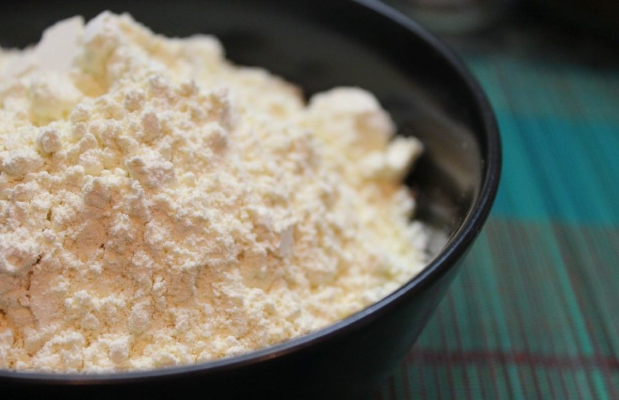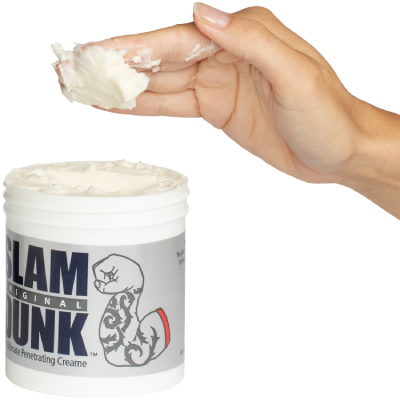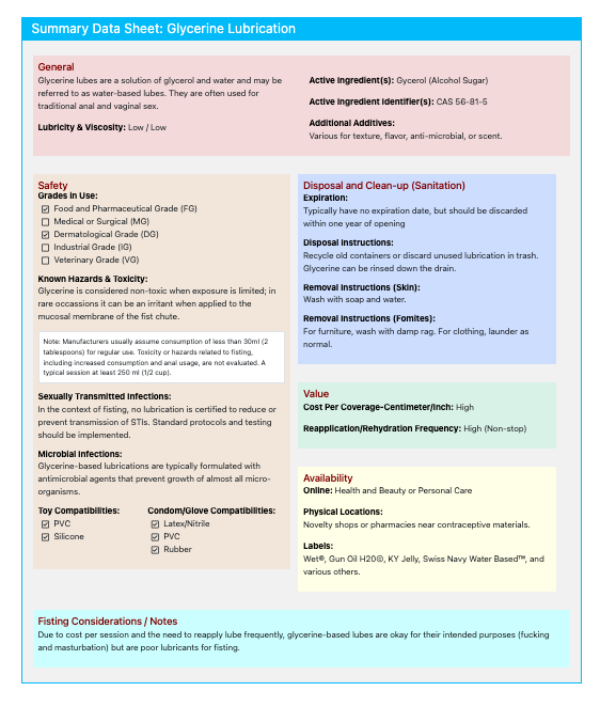Glycerine
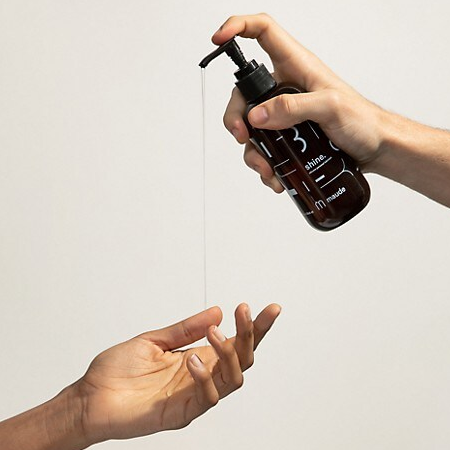
Figure 2.1: Viscosity of Glycerine
Glycerine lubes have varying viscosities; however, viscosity doesn't translate to lubricity.
Glycerine is not suitable for most fisting activities. The intestinal lining absorbs the water within the lube and rehydration of the tacky remnant is ineffective.
Pros
- Easy cleanup / non-staining
- General availability
- Edible
Cons
- Cost per coverage cm/inch
- Dehydrates quickly
- Does not rehydrate
QUICK REFERENCE
Suitability
- Foreplay, traditional sex, masturbation while fisting
- Backup/emergency use (unavailability of more suitable lubes)
Lipids
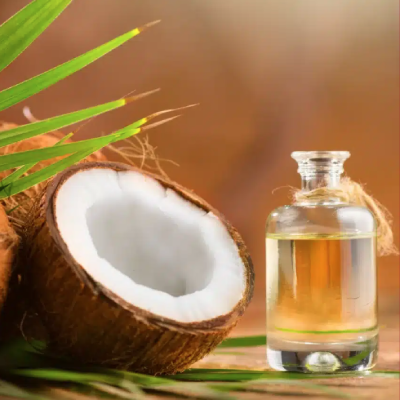
Figure 2.2: State Changes of Lipids
Many lipids, such as coconut oil, are solid or semisolid at room temperature but melt at body temperature.
Lipids are the original fisting lubricants prior to recent innovations in fisting lubes. Even with newer, highly lubricious lubricants, lipids are still utilized to protect the lining of the fist chute and provide a specific friction coefficient that can increase fisting pleasure.
Pros
- Non-toxic
- General availability
- Unique drag factor
- Edible
Cons
- Difficult in initial application
- Stains
- Odors
- Degrades latex gear and condoms
QUICK REFERENCE
Suitability
- Application of a base coat in anal canal, rectum, and upper fist chute
- Backup/emergency use (unavailability of more suitable lubes)
- Personal preference for unique drag factor
Polysaccharides
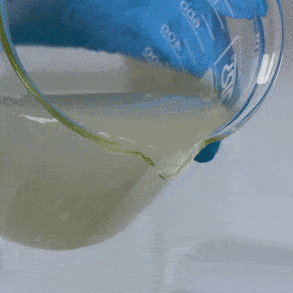
Figure 2.3: Lubricity of Polysaccharide Gums
Gums are a type of polysaccharide that is lubricious at low and high viscosities.
Polysaccharide lubes are an alternative option to non-organic lubes such as PEO, PG/PPG, silicone, and petroleum distillates. Polysaccharides are derived by multiple processes such as fermentation, milling, grinding, boiling, and other forms of mechanical extraction. The resulting products are refined into gums or cellulose. Without some type of preservative, polysaccharide lubes must be discarded promptly.
Pros
- Customizable lubricity and viscosity
- General availability (health food stores)
- Decreased cleanup time when coupled with PEOs
Cons
- Shelf life (1 day)
- Slight Odor
- May require frequent reapplication
QUICK REFERENCE
Suitability
- All fisting activities
- Backup/emergency use (unavailability of more suitable lubes)
Propylene Glycol (PG) and Polypropylene Glycol (PPG)
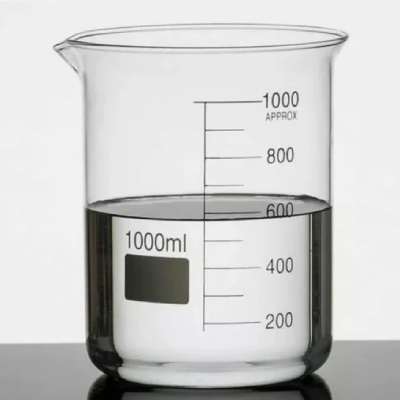
Figure 2.4: PG and PPG Ubiquity
Propylene glycol is a common ingredient in many commercial products.
Propylene glycol is a commonly used ingredient in cosmetics, foods, and pharmaceuticals. In can be synthesized from either petroleum or organic products. Fisters usually encounter PG in obstetrical/veterinary lubes.
Pros
- Inert/non-allergenic in most individuals
- Some limited antimicrobial properties
- Hypoallergenic in small doses
- Environmentally friendly
Cons
- Only available in liquid form
- Usually limited to obstetrical lubricants
- Lubricity and viscosity are not customizable
QUICK REFERENCE
Suitability
- All fisting activities
Polyethylene Oxide (PEO)
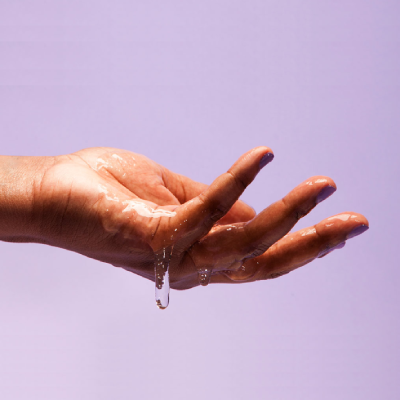
Figure 2.5: PEO Affordability
In a ratio of 1:50, PEOs provide sufficient lube to generously coat and reapply without breaking the bank.
PEO-based lubricants are the most commonly used fisting lubes. They are extremely lubricious and can be made in volumes appropriate for a single session. They are often referred to as powdered lubes or water-based lubes, though technically, water-based lube is a misnomer, as glycerine lubes are also water-based lubes.
Pros
- Inert/non-allergenic in most individuals
- High lubricity
- Highly customizable lubricity and viscosity
- Odorless
Cons
- Higher than average cleanup efforts
- Shorter shelf lives (days to weeks)
- Most common culprit of 'lube' farts
QUICK REFERENCE
Suitability
- All fisting activities
Petroleum Distillates
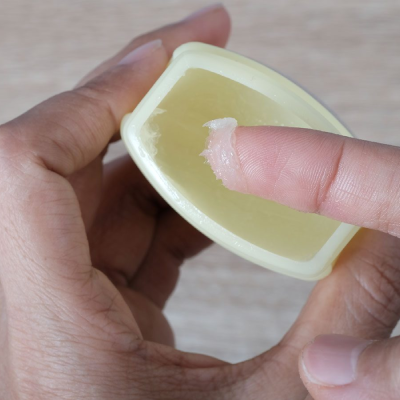
Figure 2.6: Vaseline's© Protective Barrier
Semi-solid petrolatum substances, like Vaseline©, protect against tears.
Petroleum Distillates include byproducts from the mining and refining of petroleum. Many lipid-based lube recipes add petroleum distillates to make the lube smooth and elegant. Advance fisters may use a dollop while douching to decrease harm from high velocity water and douche nozzles.
Pros
- Cost
- General availability
- Slipperiness
Cons
- Cleanup (internal & external)
- Stains
- Mild irritant to certain people
- Degrades PVC, latex gear and condoms
QUICK REFERENCE
Suitability
- Application of a base coat in anal canal
- Douching routines
- Masturbation while fisting
- Personal preference for unique drag factor
Silicone
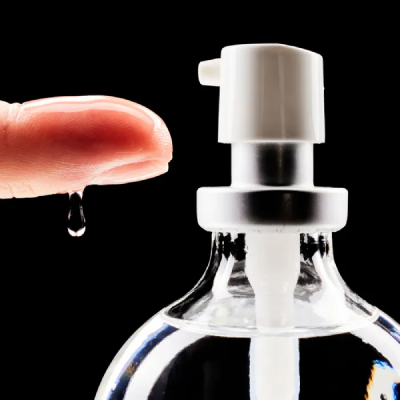
Figure 2.7: Silkiness of Silicone
Despite very low viscosity, silicone absorbs into the skin to provide good lubricity.
Silicone is rarely used as a fisting lube by advanced fisters. Novice fisters often use silicone until they are exposed to more suitable fisting lubes.
Pros
- Inert/non-allergenic
- General availability
- Unique drag factor
Cons
- Cost per coverage cm/inch
- Stains
QUICK REFERENCE
Suitability
- Application of a base coat in anal canal
- Foreplay, traditional sex, masturbation while fisting
- Backup/emergency use (unavailability of more suitable lubes)
- Personal preference for unique drag factor
Waterlock

Figure 2.8: PEO Alternative
Waterlock acts similar to PEO-based lubricants but is slightly more costly and less ubiquitous.
Waterlock is commonly used in off-the-shelf, creamy fisting lubes. It is also available as a stand-alone lube similar to PEO. It is extremely lubricious and can be made in volumes appropriate for a single session.
Pros
- Inert/non-allergenic in most individuals
- High lubricity
- Highly customizable lubricity and viscosity
- Odorless
Cons
- Shorter shelf life than PEO-based lubricants
- Difficult to acquire outside of Europe
QUICK REFERENCE
Suitability
- All fisting activities
Biologicals
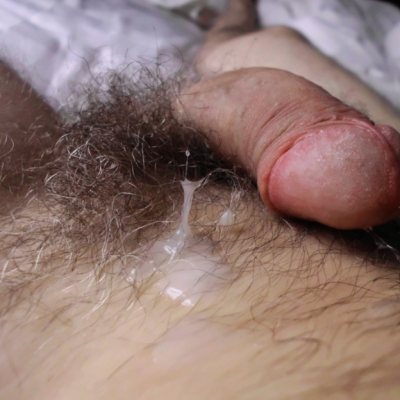
Figure 2.9: Cum and Spit
Bodily fluids provide minimal lubrication.
Various other items can be used as lube, including spit and cum, cactus and aloe extracts, gelatin, etc. These lubricants are rarely sufficient for the rigors of fisting.
Pros
- Scene enhancement (pigginess)
- All-natural
Cons
- Low/limited lubricity
- Availability
- Prep time
Suitability
- Street fairs and public venues after pre-lubing (spit)
- Post-orgasmic play (cum)
- Organic veracity (aloe, cactus, beans, etc.)


